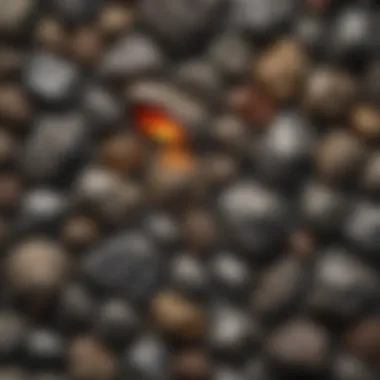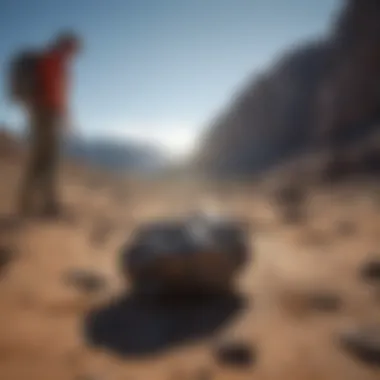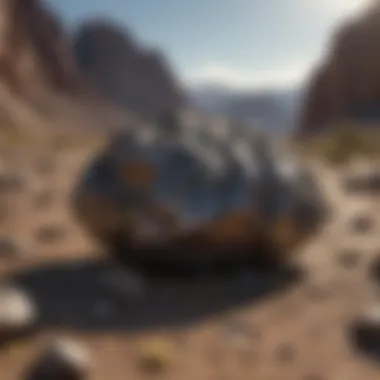Unveiling the Enigmatic World of Meteorites: A Comprehensive Guide for Rock and Fossil Enthusiasts


Rock and Fossil Identification
In the realm of meteorite collection, a keen eye for rock and fossil identification is crucial. Meteorites come in various types, each with distinctive characteristics that set them apart from common terrestrial rocks. Understanding the different types of meteorites, such as iron, stony, and stony-iron, is essential for collectors to recognize these extraterrestrial gems amidst earthly stones. When examining meteorites, enthusiasts should look for certain key characteristics that indicate their unique origin, such as regmaglypts (thumbprint-like markings) caused by atmospheric entry or fusion crusts formed during atmospheric ablation.
To aid in the accurate identification of meteorites, collectors can leverage specialized tools such as a loupe for magnification, a black light to detect fluorescence, or a streak plate to determine a specimen's streak color. By honing their skills in rock and fossil identification, enthusiasts can refine their collection and discern the celestial from the terrestrial with precision and expertise.
Introduction
What Are Meteorites?
The Basics of Meteorites
In the realm of meteorites, understanding the basics is crucial. Meteorites, fragments of asteroids or other celestial bodies that survive the journey through Earth's atmosphere, come in various types, each with its distinctive features. By exploring the basics of meteorites, readers can grasp the fundamental properties that differentiate them from common rocks. Learning about their composition, structure, and formation provides a solid foundation for further exploration into the realm of meteoritics.
Classification of Meteorites
The classification of meteorites plays a pivotal role in categorizing these extraterrestrial rocks based on their distinct characteristics. Meteorites are typically classified into three main groups: stony meteorites, iron meteorites, and stony-iron meteorites, each offering valuable insights into the diverse nature of meteoritic material. Understanding the classification system helps enthusiasts identify and study meteorites effectively. It also aids in tracing their origins and unveiling the stories they carry within their structures.
Significance of Meteorites
Impact on Earth's History
Meteorites have left a profound impact on Earth's history, shaping landscapes, and even influencing biological evolution. From causing mass extinctions to creating awe-inspiring craters, meteorite impacts have altered the course of the planet's development over millions of years. Studying the impact of meteorites on Earth's history not only provides a glimpse into the planet's tumultuous past but also highlights the dynamic relationship between space and terrestrial processes.
Scientific Value
Beyond their historical significance, meteorites hold immense scientific value. These extraterrestrial remnants offer scientists a glimpse into the formation and evolution of celestial bodies, including asteroids and the early solar system. Analyzing meteorites provides critical clues about the conditions that prevailed during the early stages of the solar system's formation, helping scientists piece together the cosmic puzzle of our origins. Their scientific value extends to studies in geology, planetary science, and astrobiology, making them invaluable resources for understanding the universe's intricate workings.
Types of Meteorites
In this comprehensive guide on unlocking the mysteries of meteorites, understanding the types of meteorites holds significant importance. Delving into the realm of meteorites allows rock and fossil enthusiasts to grasp the diversity and unique characteristics of these extraterrestrial rocks. By exploring stony meteorites, iron meteorites, and stony-iron meteorites, collectors can broaden their knowledge and appreciation for these geological treasures.
Stony Meteorites


Stony meteorites, a fascinating category within meteorite classification, encompass chondrites and achondrites. Each subtype offers distinct features that contribute to the overall allure of meteorite collection.
Chondrites
Chondrites, a prevalent type of stony meteorite, are renowned for their primitive composition and the presence of chondrules, small spherical structures formed in the early solar system. Their unique characteristics make them a sought-after choice for enthusiasts seeking to explore the origins of our solar system. The presence of chondrules distinguishes chondrites from other meteorites, providing valuable insights into the conditions of the early universe. While chondrites present a valuable opportunity for scientific research and geological understanding, collectors should note that their fusion crust may be delicate and prone to alteration.
Achondrites
In contrast, achondrites represent a subgroup of stony meteorites that lack chondrules. Their significance lies in their differentiated nature, indicating geological processes within their parent bodies that led to the formation of igneous rocks. This distinctive feature sets achondrites apart, offering collectors a glimpse into the varied processes that shaped meteoritic material. While achondrites provide valuable insights into planetary differentiation, their lack of chondrules may limit certain research avenues, highlighting the importance of considering various meteorite types in a collection.
Iron Meteorites
Exploring iron meteorites unveils a robust category characterized by their high iron and nickel content. Within this group, hexahedrites and octahedrites stand out as prominent subtypes, each with unique attributes that appeal to collectors and researchers.
Hexahedrites
Hexahedrites, a subset of iron meteorites, are distinguished by their cubic crystal structure and uniform nickel-iron composition. These meteorites exhibit a crystalline pattern that sets them apart from other iron meteorites, making them an intriguing choice for collectors interested in meteorite aesthetics and crystalline formations. The uniformity of their composition enhances their appeal for both scientific study and aesthetic appreciation.
Octahedrites
On the other hand, octahedrites feature a crystalline structure characterized by intersecting bands of kamacite and taenite, creating a distinctive Widmanstätten pattern when etched. This pattern, formed over millions of years during the slow cooling of their parent bodies, adds to the aesthetic appeal of octahedrites. Collectors are drawn to octahedrites for their intricate patterns and the opportunity to study meteorite formation processes through the examination of these unique structures.
Stony-Iron Meteorites
Lastly, stony-iron meteorites, such as pallasites, offer a blend of stony and metallic components, providing collectors with a diverse and visually captivating category of meteorites. Pallasites and meteorite classification, within the stony-iron group, showcase the fascinating interplay between metal and silicate elements.
Pallasites
Pallasites, renowned for their striking olivine crystal structures embedded in an iron-nickel matrix, combine the beauty of gem-like minerals with the metallic allure of iron-nickel alloys. Their unique composition appeals to collectors interested in both geological processes and aesthetic appreciation, making them sought after for their visual appeal and scientific value. Pallasites offer a glimpse into the complex interplay of materials within meteorites, presenting a captivating fusion of rocky and metallic components that enrich any meteorite collection.
Meteorite Classification
Moreover, understanding meteorite classification systems is crucial for enthusiasts seeking to categorize and differentiate meteorites based on specific criteria. Meteorite classification elucidates the origins, compositions, and structures of meteorites, allowing collectors to organize and study these extraterrestrial specimens effectively. By comprehending meteorite classification, enthusiasts can enhance their knowledge and appreciation of meteorites, enabling them to identify and acquire meteorites that align with their interests and goals.


Finding Meteorites
Finding meteorites is a crucial aspect of this comprehensive guide as it allows rock and fossil enthusiasts to delve into the fascinating world of these unique geological specimens. By exploring prime locations and employing specialized tools and techniques, enthusiasts can enhance their knowledge and collection of meteorites.
Prime Locations for Discovery
Deserts and Dry Lakes
Delving into the specific aspect of Deserts and Dry Lakes is imperative for rock and fossil enthusiasts aiming to discover meteorites. These arid regions offer a prime environment for meteorite preservation due to the lack of vegetation and minimal weathering processes. The key characteristic of Deserts and Dry Lakes lies in their vast expanse of barren land, which provides an ideal setting for spotting meteorites on the surface. This choice is highly beneficial for enthusiasts as the dry conditions help maintain the integrity of meteorites, making them easier to identify and recover. Despite their advantages, the remoteness of Deserts and Dry Lakes may pose logistical challenges for collectors.
Antarctica
Antarctica presents a unique and valuable opportunity for meteorite discovery, adding significant value to this article. The key characteristic of Antarctica is its pristine icy landscapes, which act as natural repositories for meteorites. The frozen terrain preserves meteorites exceptionally well, offering enthusiasts a chance to find well-preserved specimens. This choice is popular for collectors due to the high concentration of meteorites in Antarctic ice fields. However, working in Antarctica comes with challenges such as extreme weather conditions and logistical complexities. Yet, the rewards of discovering meteorites in such a unique setting outweigh the obstacles.
Tools and Techniques
Metal Detectors
Metal detectors play a pivotal role in the pursuit of meteorites, contributing significantly to this article's overarching goals. The key characteristic of metal detectors is their ability to detect metallic components within meteorites, aiding enthusiasts in locating these elusive objects. This technique is beneficial for efficient identification of meteorites among other terrestrial rocks, enhancing the collection process. The unique feature of metal detectors lies in their versatility across different terrains, providing collectors with a valuable tool for exploration. However, metal detectors may have limitations in detecting non-metallic meteorites, necessitating a multi-faceted approach to hunting.
Meteorite Hunting Strategies
Exploring meteorite hunting strategies offers rock and fossil enthusiasts a strategic framework for successful collection efforts within this guide. The key characteristic of these strategies is their systematic approach to searching for meteorites, optimizing chances of discovery. This method is popular among collectors for its structured and methodical nature, increasing efficiency in finding meteorites. The unique feature of meteorite hunting strategies is their adaptability to various environments, allowing enthusiasts to tailor their approaches based on specific terrains. Despite their advantages, these strategies require patience and perseverance, as meteorite hunting can be a time-consuming and meticulous process.
Identifying Meteorites
In this section, we delve into the crucial aspect of identification when it comes to meteorites. Identifying meteorites is an essential skill for rock and fossil enthusiasts, as it allows them to differentiate between regular rocks and these extraordinary celestial remnants. By understanding the unique characteristics of meteorites, collectors can enhance their appreciation for these geological treasures and contribute to scientific research in the field.
Characteristics to Look For
Fusion Crust:
When it comes to identifying meteorites, the fusion crust plays a significant role. The fusion crust refers to the outer layer of a meteorite that forms as it passes through the Earth's atmosphere, creating a thin, darkened exterior. This distinctive feature not only serves as a visual indicator of a meteorite's authenticity but also acts as a protective barrier, preserving the inner structure of the meteorite from weathering and contamination. Collectors value the fusion crust for its unique appearance and its ability to differentiate meteorites from terrestrial rocks.


Regmaglypts:
Another crucial characteristic to look for when identifying meteorites is regmaglypts, also known as thumbprints or sculpted surfaces. Regmaglypts are indentations or elongated cavities that form on a meteorite's surface due to ablation during its entry into the Earth's atmosphere. These sculpted features provide valuable insights into the meteorite's history and journey, highlighting the forces it encountered during its descent. Regmaglypts serve as distinct markers of a meteorite's extraterrestrial origin and are essential indicators for collectors to distinguish meteorites from Earth-origin rocks.
Testing Methods
In the process of identifying meteorites, various testing methods are employed to confirm their authenticity and composition. These methods play a critical role in determining whether a specimen is indeed a meteorite or a terrestrial rock, providing collectors with valuable insights into their discoveries.
Magnet Test:
One of the primary testing methods used in meteorite identification is the magnet test. Meteorites contain significant amounts of iron and nickel, making them magnetic. By utilizing a magnet to assess whether a specimen is attracted to it, collectors can quickly differentiate between meteorites and common rocks. The magnet test offers a simple yet effective way to confirm the presence of metallic components in a potential meteorite, guiding collectors in their identification process.
Acid Test:
Another important testing method for meteorite identification is the acid test. This test involves applying acid, typically nitric acid, to a small area of the specimen to observe its reaction. Meteorites react differently to acids compared to terrestrial rocks, with some meteorites displaying effervescence or fizzing due to the presence of certain minerals. The acid test aids collectors in determining the composition of a meteorite and verifying its extraterrestrial origins, providing additional evidence to support its classification.
Preserving and Displaying Meteorites
In this article focused on unlocking the mysteries of meteorites for rock and fossil enthusiasts, the section of Preserving and Displaying Meteorites holds significant importance. Preserving and displaying meteorites not only ensures their longevity but also allows individuals to showcase these unique geological treasures for admiration and educational purposes. By understanding the best practices for preserving and displaying meteorites, enthusiasts can maintain the integrity and visual appeal of their collections.
Cleaning Techniques
Brushing and Wiping
Within the realm of cleaning techniques for meteorites, brushing and wiping play a crucial role in ensuring the pristine appearance of these cosmic remnants. This method involves delicately removing surface dust and debris from the meteorite's exterior, allowing its natural textures and features to shine through. Brushing and wiping are popular choices among collectors as they preserve the meteorite's original aesthetics without compromising its composition. While this technique is gentle and non-invasive, enthusiasts should be cautious not to apply excessive force, which could potentially damage the meteorite.
Chemical Cleaning
Chemical cleaning is another vital aspect of maintaining meteorite collections, particularly for removing stubborn stains or deposits that cannot be eliminated through mechanical cleaning methods. This technique involves the use of specialized chemicals to dissolve contaminants without harming the meteorite's structure. However, it is crucial to exercise caution when employing chemical cleaning, as improper usage can lead to discoloration or damage. Enthusiasts should carefully follow guidelines and seek expert advice when utilizing chemical cleaning methods to ensure the preservation of their meteorite specimens.
Display Options
Mounting
When it comes to presenting meteorites for display, mounting serves as a versatile and practical option for showcasing these geological wonders. Mounting allows enthusiasts to securely position their meteorites in various orientations, highlighting different angles and features for observation. This display method not only enhances the visual appeal of the meteorite but also provides stability and protection against accidental damage. However, collectors should consider the design and material of the mount to complement the meteorite's aesthetics while ensuring its long-term preservation.
Lighting
Lighting is a crucial component of displaying meteorites effectively, as proper illumination can enhance their textures, colors, and overall visual impact. By strategically positioning light sources, collectors can create stunning displays that accentuate the unique characteristics of each meteorite. Whether using ambient lighting or focused spotlights, the right lighting can dramatically elevate the viewing experience for enthusiasts and viewers. However, it is essential to strike a balance between adequate lighting and UV protection to prevent any potential harm to the meteorite over time.







